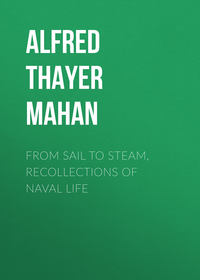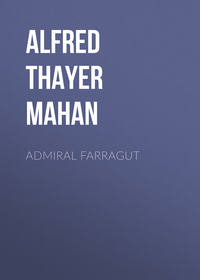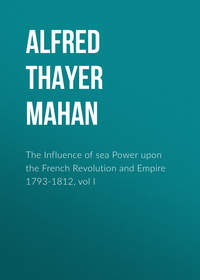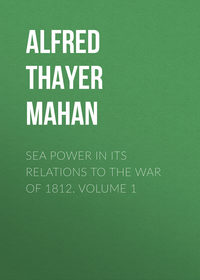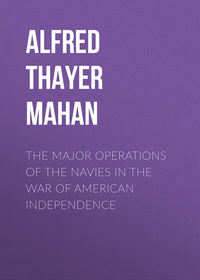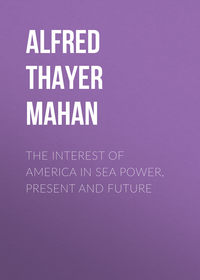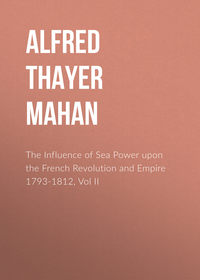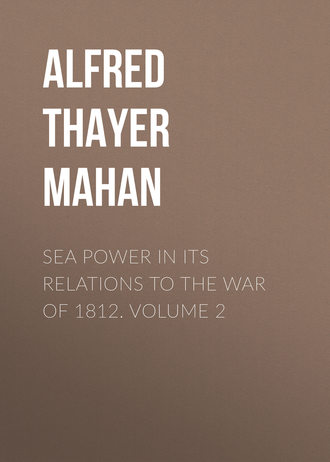 полная версия
полная версияSea Power in its Relations to the War of 1812. Volume 2
With regard to the line, however, it is apt to remark that in fleet battle, unless otherwise specially directed, the line of the assailant was supposed to be parallel to that of the defence, for the obvious reason that the attacking vessels should all be substantially at the same effective range. This distance, equal for all in fleets as usually constituted, would naturally be set, and in practice was set, by the commander-in-chief; his ship forming the point through which should be drawn the line parallel to the enemy. This rule, well established under Rodney, who died in 1792, was rigidly applicable between vessels of the same force, such as the "Lawrence" and "Niagara;" and whatever deductions might be made for the case of a light-framed vessel, armed with long guns, like the "Caledonia," keeping out of carronade distance of an opponent with heavy scantling, would not in the least apply to the "Niagara." For her, the standard of position was not, as Cooper insists, a half-cable's length from her next ahead, the "Caledonia;" but abreast her designated opponent, at the same distance as the "Lawrence" from the enemy's line. Repeated mishaps had established the rule that position was to be taken from the centre,—that is, from the commander-in-chief. Ships in line of battle, bearing down upon an enemy in like order, did not steer in each other's wake, unless specially ordered; and there is something difficult to understand in the "Niagara" with her topsail sharp aback to keep from running on board the "Caledonia," although the fact is in evidence. The expression in Perry's report of the action, "at 10 A.M. … formed the line and bore up," would by a person familiar with naval battles be understood to mean that the line was first formed parallel to the enemy, the vessels following one another, after which they steered down for him, changing course together; they would then no longer be in each other's wake, but in echelon, or as the naval phrase then went, in bow and quarter line. Barclay confirms this, "At 10 the enemy bore up under easy sail, in a line abreast."91 Thus, when the distance desired by the commander-in-chief was reached,—a fact more often indicated by his example than by signal,—the helm would bring them again in line of battle, their broadsides bearing upon the enemy.
The technical point at issue is whether Perry, finding the long-gun fire of the "Detroit" more destructive than he had anticipated, and determining in consequence to shorten the period of its duration by changing his original plan, increasing sail beyond the speed of such slower vessels as the "Caledonia," had a right to expect that his subordinates would follow his example. In the opinion of the writer, he had, in the then condition of the theory and practice of fleet battles; his transfer of his own position transferred the line of battle in its entirety to the distance relative to the enemy which he himself was seeking to assume. Were other authority lacking, his action was warrant to his captains; but the expression in his report, "I made sail, and directed the other vessels to follow, for the purpose of closing with the enemy," causes increased regret that the exact facts were not ascertained by cross-examination before a Court-Martial.
Elliott's place therefore was alongside the "Queen Charlotte," so to engage her that she could attend to nothing else. This he did not do, and for failure the only possible excuse was inability, through lack of wind. The wind was light throughout, yet not so light but that the "Lawrence" closed with the "Detroit," and the "Queen Charlotte" with her flagship when she wished. None of Elliott's witnesses before the Court of Inquiry state that he made sail before the middle of the action, but they attribute the failure to get down to the lightness of the wind. They do state that, after the "Lawrence" was disabled, a breeze springing up, sail was made; which indicates that previously it had not been. Again, it is alleged by the testimony in favor of Elliott that much of the time the maintopsail was sharp aback, to keep from running into the "Caledonia;" a circumstance upon which Cooper dwells triumphantly, as showing that the "Niagara" was not by the wind and was in her place, close astern of the "Caledonia." Accepting the statements, they would show there was wind enough to fan the "Niagara" to—what was really her place—her commodore's aid; for in those days the distance between under fire and out of fire for efficient action was a matter of half a mile.92 Perry's formulated charge, addressed to the Navy Department, and notified to Elliott, but never brought to trial, was that when coming into action an order was passed by trumpet for the vessels astern to close up in the line; that a few moments previously to the enemy's opening fire the "Niagara" had been within hail of the "Lawrence," and nevertheless she was allowed to drop astern, and for two hours to remain at such distance from the enemy as to render useless all her battery except the two long guns. Perry himself made sail at the time the hail by trumpet was passed. The "Niagara" did not.
There is little reason for doubt that the tenor of Perry's instructions required Elliott to follow the "Queen Charlotte," and no doubt whatever that military propriety imperiously demanded it of him. The question of wind must be matter of inference from the incidents above stated: the movement of the "Lawrence" and "Queen Charlotte," and the bracing aback of the "Niagara's" topsail. A sentence in Perry's report apparently, but only apparently, attenuates the force of these. He said, "At half-past two, the wind springing up, Captain Elliott was enabled to bring his vessel, the 'Niagara,' gallantly into close action." Alluding to, without insisting on, Perry's subsequent statement that he endeavored to give as favorable a color as possible to Elliott's course, it is clear enough that these words simply state that Captain Elliott at 2.30 reached the range at which the "Lawrence" had fought since a little after noon.
Quitting now the discussion of proprieties, the order of events seems to have been as follows: Perry having taken the initiative of bearing down, under increased sail, Elliott remained behind, governed by, or availing himself of—two very different motives, not lightly to be determined, or assumed, by the historian—the technical point, long before abandoned in practice, that he could not leave his place in the line without a signal. Thus his action was controlled by the position of his next ahead in the line, the dull-sailing "Caledonia," a vessel differing radically from his own in armament, having two long and for that day heavy guns, quite equal in range and efficiency to the best of the "Detroit's,"93 and therefore capable of good service, though possibly not of their best, from the distance at which Perry changed his speed. Elliott's battery was the same as Perry's. He thus continued until it became evident that, the "Queen Charlotte" having gone to the support of the "Detroit," the "Lawrence" was heavily overpowered. Then, not earlier than an hour after Perry bore down, he realized that his commander-in-chief would be destroyed under his eyes, unless he went to his support, and he himself would rest under the imputation of an inefficient spectator. He ordered the "Caledonia" to bear up, in order that he might pass (position 3; C1, C2). Though not demonstrably certain, it seems probable that the wind, light throughout, was now so fallen as to impede the retrieval of his position; the opportunity to close, used by Perry, had passed away. At all events it was not till between 2 and 2.30 that the "Niagara" arrived on the scene, within effective range of the carronades which constituted nine tenths of her battery.
With this began the second stage of the battle (3). Perry's bearing down, receiving only the support of the long guns of the "Caledonia" and of the schooners ahead of him, had brought the "Lawrence" into hot engagement with the "Detroit," supported a half hour later by the "Queen Charlotte." By a little after two o'clock both flagships were well-nigh disabled, hull and battery; the "Lawrence" most so, having but one gun left out of ten on the broadside. "At 2.30," wrote Barclay, "the Detroit was a perfect wreck, principally from the raking fire of the gunboats." Which gunboats? Evidently the "Ariel" and "Scorpion," for all agree that the rear four were at this hour still far astern, though not absolutely out of range. To these last was probably due the crippling of the "Lady Prevost," which by now had gone to leeward with her rudder injured. Up to this time, when the first scene closed, what had been the general course of the action? and what now the situation? Assuming, as is very probable, that Barclay did not open with his long 24's until Perry was a mile, two thousand yards, from him,—that distance requiring six degrees elevation for those guns,—an estimate of speeds and courses, as indicated by the evidence, would put the "Lawrence" in action, at two hundred and fifty yards, at 12.10. This calculation, made independently, received subsequent confirmation in consulting Barclay's report, which says 12.15.94 The same time, for the duller "Caledonia" and the "Niagara," would place them one thousand yards from the British line. This range, for the 32-pounder carronades of the "Niagara," and the 24's of the "Queen Charlotte," required an elevation of from four to six degrees. Coupling this with the British statement, that the carronades of the "Charlotte" could not reach the "Niagara," we obtain probable positions, two hundred and fifty yards and one thousand yards, for the principal two American vessels at quarter-past noon.
From the general lightness and occasional failure of the wind up to 2 P.M., it is more than likely that no great change took place before that hour. What air there was might touch all alike, but would affect least the "Lawrence," "Detroit," and "Queen Charlotte," because their sails were being rent; and also they were in the centre of the cannonade, which is believed usually to kill the breeze. The tendency of the "Caledonia," "Niagara," and American vessels in rear of them, between 12.30 and 2 P.M., during which period, to use Barclay's report, "the action continued with great fury," would therefore be to approach slowly the scene where the "Lawrence," supported by the long guns of the "Ariel," "Scorpion," and "Caledonia," maintained the day against the "Detroit" and "Queen Charlotte," backed by the schooner "Chippewa" and the 6 and 4 pounder pop-guns of the "Hunter." How near they drew is a mere matter of estimate. Taking all together, it may be inferred that the "Niagara" had then been carried as close as five hundred to six hundred yards to the British line, but it would appear also towards its rear; rather, probably, that the British had advanced relatively to her, owing to her course being oblique to theirs.
The situation then was as follows: The "Lawrence," disabled, was dropping astern of the "Detroit," "Queen Charlotte," and "Hunter." More than half her ship's company lay dead or wounded on her decks. Her loss, 83 killed and wounded out of a total of 142,—sick included,95—was mostly incurred before this. With only one gun left, she was a beaten ship, although her colors were up. The "Detroit" lay in the British line almost equally mauled. On her lee quarter,—that is, behind, but on the lee side,—and close to her, was the "Queen Charlotte." Her captain, second to Barclay, had been killed,—the first man hit on board,—and her first lieutenant knocked senseless; being succeeded in command by an officer whom Barclay described as of little experience. The first lieutenant of the "Detroit" was also wounded mortally; and Barclay himself, who already had been once hit in the thigh, was now a second time so severely injured,—being his eighth wound in battle, though now only thirty-two,—that he was forced at this critical instant to go below, leaving the deck with the second lieutenant. The "Hunter" was astern of her two consorts. The "Lady Prevost," fifth in the British order, had fallen to leeward with her rudder crippled. The position of the leading and rear British schooners is not mentioned, and is not important; the reliance of each being one long 9-pounder gun.
Before this, taking advantage of the breeze freshening, the "Niagara" had gone clear of the "Caledonia," on her windward side, and had stood to the southwest, towards the "Detroit." She had not at first either foresail or topgallantsails set; and since she passed the "Lawrence" to windward, she was then almost certainly over two hundred and fifty yards from the British line, for there is no conclusive proof that the "Lawrence" was nearer than that. Combining the narrative of the British commodore with that of his second lieutenant, who now took charge, it appears that Barclay, before going below, saw a boat passing from the "Lawrence" to the "Niagara," and that the second lieutenant, Inglis, after relieving him, found the "Niagara" on the weather beam of the "Detroit." Perry, seeing the "Lawrence" incapable of further offensive action, had decided to leave her and go on board the "Niagara," and in this brief interval was making his passage from one vessel to the other. After leaving the "Lawrence" astern, the "Niagara" had made sail; the foresail having been set, and the topgallantsails "in the act of being set, before Captain Perry came on board."96 This necessarily prolonged the time of his passage, and may have given rise to the opprobrious British report that she was making off. Her making sail as she did indicated that she had suffered little aloft; she had been out of carronade range, while her consort, still in fighting condition, was bearing the brunt; it was natural to conclude that she would not alone renew the action, now that the "Lawrence" was hopelessly disabled. The wish, too, may possibly have helped the thought. The "Lawrence," in fact, having kept her colors flying till Perry reached the "Niagara," struck immediately afterwards. Had she surrendered while he was on board, he could not honorably have quitted her; and the record was clearer by his reaching a fresh ship while the flag of the one he left was still up.
What next happened is under no doubt so far as the movements of the "Niagara" are concerned, though there is irreconcilable difference as to who initiated the action. Immediately after Perry came on board, Elliott left her, to urge forward the rear gunboats. Her helm was put up, and she bore down ahead of the "Detroit" to rake her; supported in so doing by the small vessels, presumably the "Ariel," "Scorpion," and "Caledonia." The British ship tried to wear, both to avoid being raked and to get her starboard battery into action; many of the guns on the broadside heretofore engaged being disabled. The "Charlotte" being on her lee quarter, and ranging ahead, the two fell foul, and so remained for some time. This condition gave free play to the American guns, which were soon after re-enforced by those of the rear gunboats; enabled, like the "Niagara," to close with the freshening breeze. After the two British vessels got clear, another attempt was made to bring their batteries to bear; but the end was inevitable, and is best told in the words of the officer upon whom devolved the duty of surrendering the "Detroit." "The ship lying completely unmanageable, every brace cut away, the mizzen-topmast and gaff down, all the other masts badly wounded, not a stay left forward, hull shattered very much, a number of guns disabled, and the enemy's squadron raking both ships ahead and astern, none of our own in a position to support us, I was under the painful necessity of answering the enemy to say we had struck, the 'Queen Charlotte' having previously done so."97 A Canadian officer taken prisoner at the battle of the Thames saw the "Detroit," a month later, at Put-in Bay. "It would be impossible," he wrote, "to place a hand upon that broadside which had been exposed to the enemy's fire without covering some portion of a wound, either from grape, round, canister, or chain shot."98 Her loss in men was never specifically given. Barclay reported that of the squadron as a whole to be forty-one killed, ninety-four wounded. He had lost an arm at Trafalgar; and on this occasion, besides other injuries, the one remaining to him was so shattered as to be still in bandages a year later, when he appeared before the Court Martial which emphatically acquitted him of blame. The loss of the American squadron was twenty-seven killed, ninety-six wounded; of whom twenty-two killed and sixty-one wounded were on board the "Lawrence."
Thus was the battle of Lake Erie fought and won. Captain Barclay not only had borne himself gallantly and tenaciously against a superior force,—favored in so doing by the enemy attacking in detail,—but the testimony on his trial showed that he had labored diligently during the brief period of his command, amid surroundings of extreme difficulty, to equip his squadron, and to train to discipline and efficiency the heterogeneous material of which his crews were composed. The only point not satisfactorily covered is his absence when Perry was crossing the bar. In his defence his allusion to this incident is very casual,—resembles somewhat gliding rapidly over thin ice; but the Court raised no question, satisfied, probably, with the certainty that the honor of the flag had not suffered in the action. On the American side, since the history of a country is not merely the narrative of principal transactions, but the record also of honor reflected upon the nation by the distinguished men it produces, it is proper to consider the question of credit, which has been raised in this instance. There can be no doubt that opportunity must be seized as it is offered; for accident or chance may prevent its recurrence. Constituted as Perry's squadron was, the opportunity presented to him could be seized only by standing down as he did, trusting that the other vessels would follow the example of their commander. The shifting of the wind in the morning, and its failure during the engagement, alike testify to the urgency of taking the tide as it serves. There was no lagging, like Chauncey's, to fetch up heavy schooners; and the campaign was decided in a month, instead of remaining at the end of three months a drawn contest, to lapse thenceforth into a race of ship-building. Had the "Niagara" followed closely, there could have been no doubling on the "Lawrence"; and Perry's confidence would have been justified as well as his conduct. The latter needs no apology. Without the help of the "Niagara," the "Detroit" was reduced to a "defenceless state," and a "perfect wreck,"99 by the carronades of the "Lawrence," supported by the raking fire of the "Ariel" and "Scorpion." Both the expressions quoted are applied by the heroic Barclay to her condition at 2.30, when, as he also says, the "Niagara" was perfectly fresh. Not only was the "Detroit" thus put out of action, but the "Charlotte" was so damaged that she surrendered before her. To this the "Caledonia's" two long twenty-fours had contributed effectively. The first lieutenant of the "Queen Charlotte" testified that up to the time he was disabled, an hour or an hour and a quarter after the action began, the vessel was still manageable; that "the 'Niagara' engaged us on our quarter, out of carronade range, with what long guns she had; but our principal injury was from the 'Caledonia,' who laid on our beam, with two long 24-pounders on pivots, also out of carronade-shot distance."100
Is it to Perry, or to Elliott, that is due the credit of the "Niagara's" action in bearing up across the bows of the "Detroit"? This is the second stage of the battle; the bringing up the reserves. An absolute reply is impossible in the face of the evidence, sworn but not cross-examined. A probable inference, which in the present writer amounts to conviction, is attainable. Before the Court of Inquiry, in 1815, Captain Elliott put the question to several of his witnesses, "Was not the 'Niagara's' helm up and she standing direct for the 'Detroit' when Captain Perry came on board?" They replied, "Yes." All these were midshipmen. By a singular fatality most of the "Niagara's" responsible officers were already dead, and the one surviving lieutenant had been below, stunned, when Perry reached the deck. It may very possibly be that this answer applied only to the first change of course, when Elliott decided to leave his position behind the "Caledonia"; but if it is claimed as covering also the subsequent bearing up eight points (at right angles), to cross the bows of the "Detroit," it is to be observed that no mention of this very important movement is made in a letter addressed to the Secretary of the Navy, October 13, 1813, one month after the battle, drawn up for the express purpose of vindicating Elliott, and signed by all the lieutenants of the "Niagara," and by the purser, who formerly had been a lieutenant in the navy. Their account was that Perry, on reaching the ship, said he feared the day was lost; that Elliott replied it was not, that he would repair on board the rear schooners, and bring them up; that he did so, and "the consequence was that in ten minutes the 'Detroit' and 'Queen Charlotte' with the 'Lady Prevost,' struck to us, and soon after the whole of the enemy's squadron followed their example."101 This attributes the victory to the half-dozen long guns of the four schooners, mostly inferior in caliber to the nine carronades on board a single vessel, the "Niagara," raking within pistol-shot of antagonists already in the condition described by Barclay. Such a conclusion traverses all experience of the tactical advantage of guns massed under one captain over a like number distributed in several commands, and also contravenes the particular superiority of carronades at close quarters. An officer of the "Detroit," who was on deck throughout, testified that the "Lawrence" had engaged at musket-shot, the "Niagara," when she bore down under Perry, at pistol-shot. Barclay, and his surviving lieutenant, Inglis, both lay most weight upon this action of the "Niagara," from which arose also the fouling of the two largest British ships.
Perry's charges of 1818 against Elliott formulated deliberate statements, under the responsible expectation of cross-examination under oath. This is his account: "When the commanding officer [Perry] went on board the 'Niagara,' Captain Elliott was keeping her on a course by the wind, which would in a few minutes have carried said vessel entirely out of action, to prevent which, and in order to bring the said vessel into close action with the enemy, the said commanding officer was under the necessity of heaving-to, stopping and immediately wearing said vessel, and altering her course at least eight points"; that is, perpendicular to the direction before steered. Against this solemn and serious charge is unquestionably to be placed the commendatory mention and letter given by Perry to Elliott immediately after the battle. Upon these also he had to expect the sharpest interrogation, to the mortification attendant upon which he could only oppose evidence extenuative of, but in no case justifying, undeniable self-contradiction. If the formal charge was true, no excuse can be admitted for the previous explicit commendation. As a matter of historical inquiry, however, such contradictions have to be met, and must be weighed in the light of all the testimony. The author's conclusion upon the whole is that, as Perry's action in first standing down insured decisive action, so by him was imparted to the "Niagara" the final direction which determined victory. The influence of the rear gunboats brought up by Elliott was contributive, but not decisive.
In short, the campaign of Lake Erie was brought to an immediate successful issue by the ready initiative taken by Perry when he found the British distant fire more destructive than he expected, and by his instant acceptance of necessary risk, in standing down exposed to a raking cannonade to which he for a long while could not reply. If, as the author holds, he was entitled to expect prompt imitation by the "Niagara," the risk was actual, but not undue. As it was, though the "Lawrence" surrendered, it was not until she had, with the help of gunboats stationed by Perry for that object, so damaged both her opponents that they were incapable of further resistance. In the tactical management of the "Lawrence" and her supports was no mere headlong dash, but preparation adequate to conditions. Had the "Niagara" followed, the "Lawrence" need never have struck. The contemporary incidents on Erie and Ontario afford an instructive commentary upon Napoleon's incisive irony, that "War cannot be waged without running risks." There has been sufficient quotation from Chauncey to indicate why the campaign on Ontario dragged through two seasons, and then left the enemy in control. Small as the scale and the theatre of these naval operations, they illustrate the unvarying lesson that only in offensive action can defensive security be found.




